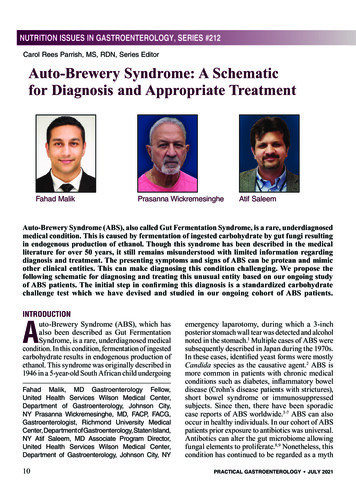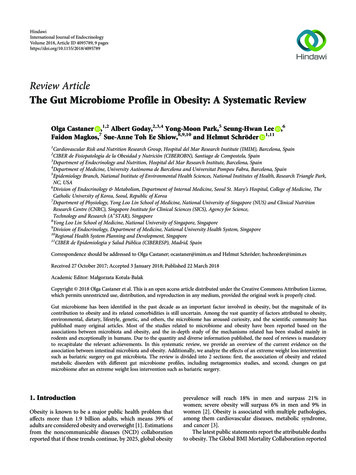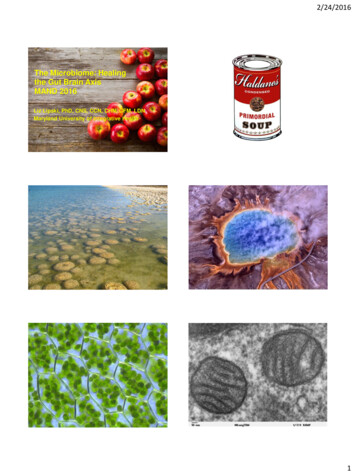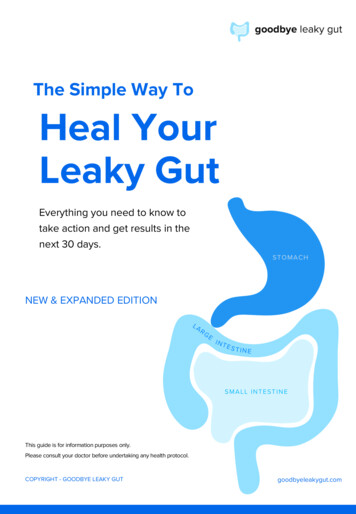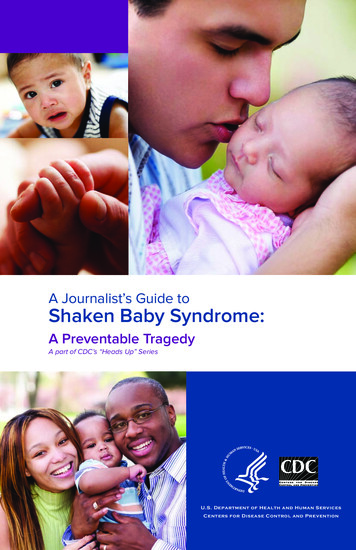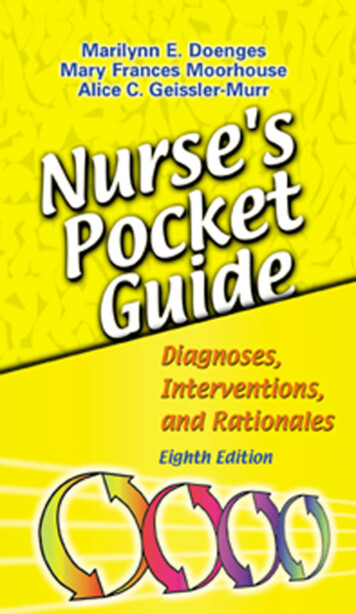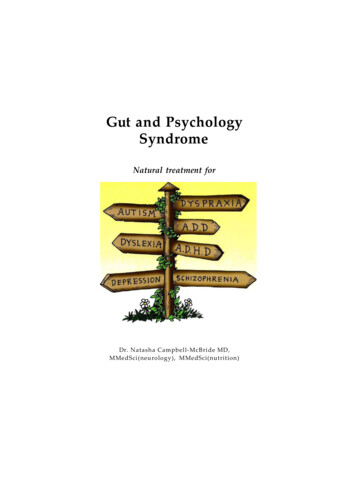
Transcription
Gut and PsychologySyndromeNatural treatment forDr. Natasha Campbell-McBride MD,MMedSci(neurology), MMedSci(nutrition)
Dr. Natasha Campbell-McBride set up The CambridgeNutrition Clinic in 1998. As a parent of a childdiagnosed with learning disabilities, she was acutelyaware of the difficulties facing other parents like her, and shehas devoted much of her time to helping these families. Sherealised that nutrition played a critical role in helpingchildren and adults to overcome their disabilities, and haspioneered the use of probiotics in this field.Her willingness to share her knowledge has resulted in hercontributing to many publications, as well as presenting atnumerous seminars and conferences on the subjects of learning disabilities anddigestive disorders. This book captures her experience and knowledge, incorporatingher most recent work.She believes that the link between learning disabilities, the food and drink that wetake, and the condition of our digestive system is absolute, and the results of her workhave supported her position on this subject. In her clinic, parents discuss all aspectsof their child's condition, confident in the knowledge that they are not only talking toa professional but to a parent who has lived their experience. Her deepunderstanding of the challenges they face, puts her advice in a class of it's own.NatashaCampbell-McBrideholds a Degree in Medicine and Postgraduate Degrees inboth Neurology and Human Nutrition. In her clinic in Cambridge she specialises inNutrition for Children and Adults with Behavioural and learning Disabilities, andAdults with Digestive and Immune System DisordersDr Natasha Campbell-McBride is to be congratulated on puttingtogether such a well-researched and provocative book. I warmlyr e c o m m e n d it.Dr Basant KPuri,Consultant Psychiatrist,ImperialCollege,London,UKDr Campbell-McBride has done an excellent job of summarisingthe nutritional biochemical connections with psychiatric andneurological disorders and gastrointestinal function. The book isfull of valuable and interesting facts that can be used by people tooptimise the health of themselves and their children.Dr. William Shaw, Ph.D., Great Plains Laboratories, Kansas, USAThe book contains basic information for thebeginner as well as in-depth informationfor those at an advance level. Thank youDr Campbell-McBride for writing this book.Dr. Stephen M. Edelson, Ph.D., Centre for theStudy of Autism, Oregon, USA 14.95I9SBN0-9548520-0-1780954852009
Gut and PsychologySyndromeNatural treatment forDr. Natasha Campbell-McBride MD,MMedSci(neurology), MMedSci(nutrition)
Copyright 2004 by Natasha Campbell-McBrideGut and Psychology SyndromeISBN 10: 0-9548520-0-1ISBN 13: 978-0-954-85200-9First published in United Kingdom in September 2004 byMedinform Publishing10 Adelaide CloseSohamCambridge CB7 5FJFirst reprint February 2005Second reprint August 2005Third reprint March 2006Fourth reprint July 2006Fifth reprint October 2006Sixth reprint November 2006Seventh reprint May 2007Eighth reprint November 2007Ninth reprint April 2008Tenth reprint August 2008Eleventh reprint November 2008The right of Dr. Natasha Campbell-McBride to be identified as the authorof this work has been asserted by her in accordance with the Copyright,Patent and Designs Act 1988.All rights reserved. No part of this work may be reproduced, stored in aretrieval system, or transmitted in any form or by any means without priorwritten permission of the author.Printed by Halstan Printing Group, Amersham, BuckinghamshireIllustrations by Peter Kent
To my sons, Nicholas and Matthew, and to my husband, Peter,without whose support and encouragement this book would neverhave been written.
REVIEWSDr. Natasha Campbell-McBride is to be congratulated on putting togethersuch a well-researched and provocative book. From the over-use of antibiotics to the promotion of breast-feeding and healthier diets,Dr. Campbell-McBride writes with the authority of a practising doctor andwith the warmth and feeling of a mother of a child with autism. Everyparent with a child who has autism, attention-deficit hyperactivity disorder, dyslexia or dyspraxia will find much to value in this book, which inturn delights and shocks the reader. I warmly recommend it.Dr Basant K Puri,MA, PhD, MB, BChir, BSc MathSci, MRCPsych, DipStat,MMath, Head of the Lipid Neuroscience Group, MRI Unit, HammersmithHospital, Imperial College, London; and author of the books The NaturalWay to Beat Depression; Chronic Fatigue Syndrome; and Natural Energy.Dr. Natasha Campbell-McBride has done an excellent job of summarisingthe nutritional biochemical connections with pyschiatric and neurologicaldisorders and gastrointestinal function. She has done an admirable job inrelating specific digestive disorders in conditions such as schizophrenia,autism, attention deficit disorder and other problems of child development. The book is full of valuable and interesting facts that can be used bypeople to optimise the health of themselves and their children.Dr.William Shaw, PhD., Great Plains Laboratories, Kansas,USADr. Campbell-McBride's book provides important information and greatinsight into the understanding and treatment of gastrointestinal disordersin those with developmental disabilities and other disorders. The bookcontains basic information for the beginner as well as in-depth information for those at an advance level. Thank you Dr. Campbell-McBride forwriting this book.Dr. Stephen M. Edelson, Ph.D., Center for the Study of Autism,Oregon USA.
This book is fantastic and will become a classic. Every medic should haveone. No, every household should have one!An invaluable resource for patients with 'syndrome diseases' andso-called 'mental health problems'. The medicine of the future already inpractice.Martina Watts BA(Hons)practisingnutritionistDipION MBANT,and journalistThis book presents the case for investigating the nutritional aspects, howthe gut works and how poor gut function seriously impacts not onlyphysical health but also brain function, for all children with learning andbehaviour difficulties.Countless parents seeking help from The Hyperactive Children's SupportGroup find their children benefit greatly from dietary and nutritionalinterventions. Vitamin, mineral and essential fatty acid deficiencies are alltoo frequently discovered.This book offers an insight to how the digestive system affects the brain.Sally Bunday, Founder Director,The Hyperactive Children's Support Group, UK
WICKEN FENThe old wooden gates swinging wide openleaving room for a path of wood stretching out in front of you.The heavenly scent of the clean fresh air.The whistling sound of the grass and the treesswaying left and right in the breeze.At night you stare at the wonderful sight.The path leading over the moist soft grass.You walk on the bridge over a gently flowing river.The hill reaching so high, almost touching the sky.The windmill still stands as you walk the stairswhich have been there for years.The buzzing of the bees busy in their hive.All the sounds surround you.The warm feeling of welcome is quick to arrive.The sun shining bright on the grassas green as the leaves in summer.The way forward getting thinner leaving the feeling that lasts.The adventure is over.Feeling warm inside.Farewell until next time.Nicholas Campbell-McBride,11 years old,Cambridge, UK
-anOpenLetter15Part One: What Is Going On?1.All Diseases Begin in the Gut2.The Roots of a Tree153.Immune System254. What Can Damage Gut Flora?5.The Opportunistic Flora6. The Gut-Brain Connection7.The Families8.Vaccinations. Does MMR Cause Autism?9.SchizophreniaPart Two:Diet9313745535963Treatment1.The Diet - A Discussion2.The Appropriate Diet for GAP Syndrome933.Recipes1 1 94.It's Feeding Time! Oh, No!1 5 771
Supplementation for Children and Adults with GAP SyndromeProbiotics1.1631652.Fats: The Good and the Bad3.Vitamin4.Digestive Enzymes5.Vitamin and Mineral SupplementationA187Detoxification for People with GAPSPart Three; Different Issues1.Ear Infections and Glue Ear2.TopTenInfluences,whichBoostImmunity2213. Top Ten Influences, which Damage Immunity 2234. Constipation 2255.Genetics2296. A Few Words About EducationSelected ReferencesIndex235243261
To THE PARENTS OFA U T I S T I C CHILDREN - AN O P E N LETTERNot many people would choose to become parents of an autistic child. Yetit is happening to more and more of us in our modern world. There is anunmistakable epidemic of autism going on across the globe. If this canpossibly be of any comfort for a parent, then I would say that you arecertainly not alone!Autism used to be a rare disorder, so that the majority of doctors neversaw it in their practice and most people had never heard of it. Fifteen yearsago in western countries the incidence of autism used to be on average onechild in 10,000. Now according to the UK Department of Health 1 in 166children in Great Britain are diagnosed with autism. According to the USACentre for Disease Control (CDC around 1 out of 150 American children arediagnosed with autistic spectrum disorders now and the numbers aregrowing every day. Similar numbers are reported by the Autism CanadaFoundation. A Finnish study published in the European Journal of Childand Adolescent Psychiatry (2001, volume 9) reported an incidence rate of 1child in 483 diagnosed autistic in Finland. In Sweden a rate of 1 child in 141was reported.So, what is happening? Why do we have such a dramatic increase innumbers of children falling prey to this terrible disorder, deemed incurableby orthodox medicine?Is the reason for this epidemic genetic? The truth is - we don't know!However, what we do know, is that genetic disorders do not show such asudden increase in incidence. Genetics just don't work that way. This kindof increase in new diagnosis of autism cannot be explained by genetics. Onthe contrary, it provides a strong argument to support the statement, thatgenetics may not play an important part in the development of autismafter all.Is this epidemic due to better diagnosis? That is what some very wellestablished British medical experts are trying to tell us. So, in effect are theysaying that 10 years ago doctors in the UK were so bad at recognising anddiagnosing autismcase, where are all these children today? They would by now be teenagers
with autism, because we know that this disorder does not disappear withage. We clearly do not have 1 in 166 teenagers in the UK with autism. So, thisargument does not convince anybody. Something else is going on.Something that cannot simply be explained away and something thatcannot be fixed with a pill.Most parents of autistic children can clearly recall that traumaticmoment of the diagnosis of "Autism" being announced to them by a doctorfollowed by the statement "There is nothing that can be done." Well, beinga doctor myself, I have to say that your doctor is wrong, there is a lot thatcan be done! I would even go further, depending on your commitment andcertain circumstances, you have a good chance of bringing your child asclose as possible to normality! Hundreds of autistic children across theglobe, appropriately treated and educated become almost indistinguishable from their typically developing (normal) peers. The sooner the treatment starts - the better are the results, because the younger the child is, theless damage there is to undo and also because they have less catching up todo in their development with normal children of their age. Thankfully, themedical professionals, though often being unhelpful as far as treatment isconcerned, are much better nowadays at diagnosing autism. The majorityof children get diagnosed by the age of three, which was not the case 10-15years ago. Receiving the diagnosis so early gives the parents a chance tostart acting early, which gives the child a better chance of recovery.In the western world there is a general tendency to delegate responsibility for our health to the medical profession. If you are ill you go to thedoctor. When it comes to autism, after establishing the diagnosis, officialmedicine has virtually nothing to offer the child. It is a big shock for parents to suddenly find themselves facing this monster called "Autism" ontheir own. Most of the parents I have met are intelligent and often welleducated people. The first thing they do is to learn as much as possible.Today there is a whole world of information available on the subject ofautism, including solid scientific research. Looking at the amount ofresearch done in other areas of medicine in the last 10 years, it is often lessthan what has been achieved in the field of autism. I believe the reason isthat research in autism is almost entirely driven by the most motivatedpeople on Earth - the parents of autistic children. Among them are doctors,biochemists, biologists and simply intelligent people looking for solutionsto their child's problem. There is a network of parent organisations acrossthe world keen to share information and help each other. I know a lot ofparents who would spend hours on the phone to comfort and help another
parent in the same situation. Treating autism is not an easy task. It takesyears of continuous effort and commitment. But, being a parent myself, Ican tell you that it is one of the most rewarding experiences on Earth! Inthis book I would like to share with you what I strongly believe to be theappropriate treatment for an autistic child.Information on nutrition is not included into the curriculum of westernmedical schools and consequently doctors have very little idea about thevalue of nutrition in the treatment of disease. Yet appropriate nutrition is acorner-stone of any successful treatment for any chronic disease Autismand other learning disabilities are no exception. There are many popularmisconceptions in this area, which have to be clarified.Autism used to be a diagnosis considered hopeless. With all the knowledge we have today it is very far from that. And we are still learning everyday. Children diagnosed today are much more fortunate than childrendiagnosed ten years ago (if the word fortunate can be used at all), becausetheir parents have so much more information available to them to starthelping their child immediately. Ten years ago we did not know half of whatwe know today. Parents of newly diagnosed children now have no time todespair - there is too much learning to do! I think, that is very positive. Thelearning rollercoaster, your child will take you through, will change yourlife forever. Who knows, it may open new horizons and opportunities foryou, as it has done for so many people.So, let's keep learning!
INTRODUCTIONThis book has evolved over a period of three years when I worked withhundreds of children in my clinic. Initially the book was planned to beabout autism as the majority of children who came to see me were indeedautistic. However, the more children I saw the more it became clear that wehave other epidemics emerging. Attention deficit disorder with hyperactivity and without it (ADHD/ADD), dyspraxia, dyslexia, various behaviouraland learning problems, allergies, asthma, eczema - all have reached epidemic proportions. But more than that these seemingly unrelated conditions overlap with each other. After years of working with the children inmy clinic I hardly met one child who presented with just one of the aboveconditions. Every child has two, three or more of these health problems atonce. For example, a child would present with allergies; at the same timethe parents would describe a couple of asthmatic episodes and eczemaand then would talk about their child's extreme clumsiness (dyspraxia) andlearning problems. A large percent of allergic and asthmatic children aredyspraxic and hyperactive to various degrees. Many of them have problems with concentration and attention span, which affect their learningability. There is an approximate 5 0 % overlap between dyslexia and dyspraxia and a 30 5 0 % overlap between ADHD and dyslexia. Children whosuffer severe eczema in infancy quite often develop autistic features laterin life. Autism and ADHD overlap with every one of the above-mentionedconditions. Apart from being hyperactive many autistic children havesevere allergies, asthma, eczema, dyspraxia and dyslexia.
ismTHE OVERLAPPING PICTUREAs we can see, modern medicine has created all these separate diagnosticboxes to fit our children in. But the modern child does not fit into any oneof them; the modern child fits into this rather lumpy picture.Why are all these conditions related? What underlying problem are wemissing in our children which makes them susceptible to asthma, eczema,allergies, dyspraxia, dyslexia, behavioural problems, ADHD and autism indifferent combinations? Why when they become teenagers, do many ofthese children fall prey to substance abuse? Why do many of these childrengrow up to become diagnosed with schizophrenia, depression, bipolar disorder and other psychological and psychiatric problems?To answer all these questions we have to look at one factor, which unitesall these patients in a clinical setting. This factor is the state of their digestive system. I have yet to meet a child with autism, ADHD/ADD, asthma,eczema, allergies, dyspraxia or dyslexia, who has not got digestive abnormalities. In many cases they are severe enough for the parents to start talking about them first. In some cases the parents may not mention theirchild's digestive system, yet when asked direct questions would describe aplethora of gut problems. But what have digestive abnormalities got to dowith autism, hyperactivity, inability to learn, mood and behaviour problems? According to recent research and clinical experience - a lot! In fact itappears that the child's digestive system holds the key to the child's mentaldevelopment. The underlying disorder, which can manifest itself in
INTRODUCTION7different children with different combinations of symptoms, resides in thegut! Rather than trying to fit a child with autistic tendencies, asthma,eczema and hyperactivity or a child with dyspraxia, dyslexia and allergiesinto any particular diagnostic box we need to have a name for the underlying disorder, which originates in the gut and manifests itself as anycombination of the above conditions.Here I propose a name: Gut And Psychology Syndrome or GAPSyndrome. Children with GAP Syndrome often fall into the gap - the gap inour medical knowledge. As a result they do not receive appropriate treatment. In the following chapters we are going to talk in detail about whatthe GAP Syndrome means, how it develops and how to treat it.Apart from childhood learning disabilities: autism, ADHD/ADD,dyslexia, dyspraxia and various learning and behavioural problems, thereis another group of conditions which fit into the GAP Syndrome. Theseconditions are schizophrenia, depression, manic depression or bipolar disorder and obsessive compulsive disorder. The father of modern psychiatryFrench psychiatrist Phillipe Pinel (1745-1828), after working with mentalpatients for many years, concluded in 1807: "The primary seat of insanitygenerally is in the region of the stomach and intestines." And yet, the lastthing a modern psychiatrist would pay attention to is the patient's digestive system! We will discuss the scientific and clinical evidence pointing inthe direction of gut-brain connection in schizophrenic patients.It is beyond the scope of this book to look at other psychiatric conditions. Hopefully, future clinical experience and research will shed light onhow many of them may belong to Gut And Psychology Syndrome. Herewe will concentrate on the conditions which receive the diagnostic labelsof Autistic Spectrum Disorder, ADHD/ADD, Dyslexia, Dyspraxia andSchizophrenia. This book may also be useful for patients who arediagnosed with allergies, including asthma and eczema.
PART ONE:WHAT IS GOING O N ?1.ALL DISEASESBEGIN IN THE G U THippocrates,460-370BCGAPS children and adults have digestive problems, sometimes quitesevere. Colic, bloating, flatulence, diarrhoea, constipation, feeding difficulties and malnourishment, all to various degrees, are a typical part ofautism, schizophrenia and other GAPS conditions. Doctors often explainthese symptoms as a result of patient's "funny" feeding habits and are notinclined to investigate them.Whether we look at a child or an adult with GAPS, in the majority ofcases digestive problems start at weaning time or times when breast milkgets replaced with formula milk and other foods get introduced. In manycases parents clearly remember that the diarrhoea or constipation startedin the second year, but thinking back would recall that their child had colic,vomiting (reflux) or other digestive symptoms in the first year as well. Incases of GAPS adults it is important to speak to the parents of the patient (ifpossible) in order to collect a detailed medical history starting from birth.In those cases where an adult did not have a history of gut problems fromchildhood the digestive problems would start later in life due to somehealth-damaging event.The second year of life is the time when many GAPS children start developing fussy eating habits, refusing a whole lot of foodstuffs and limitingtheir diet to a handful of foods, usually starchy and sweet: breakfast cereals, crisps, chips, popcorn, cakes, biscuits, sweets, bananas, bread, rice,sweet yoghurts. Most of these children would refuse to have vegetables,fruit (apart from bananas), meats, fish and eggs. About 60-70% of the autistic children I have seen in my clinic would have an extremely limited diet,consisting sometimes of two or three items. It is quite rare to meet an autistic child who is not fussy with food. Other GAPS children may not be as
extreme as autistic children but the majority of them also limit their dietsin the same typical fashion.It is also very rare for parents of GAPS children to describe their child'sstool as normal. The picture is particularly striking in autistic children.Diarrhoea and constipation would often alternate and, in many casesundigested food is clearly visible in the stool. Very often the stool wouldhave an extremely strong, unpleasant smell and at other times it is so liquidand frothy that the child cannot hold it. Sometimes the stool would be veryacid and burn the child's skin in the nappy area. In many cases the stoolhas a pale whitish colour and floats on the surface of the water, indicatingthat the child is unable to digest fats. Often the child would have suchsevere constipation, that he or she would not open the bowel for 5-7 ormore days, which then would result in an extremely large and painful stool.This sort of experience makes children fearful of passing stool, so they holdon for as long as they can, making the whole problem even worse. In somecases parents do not notice anything wrong with the stool, but when askedwould acknowledge that their child has pronounced flatulence and bloating. In many of these cases the child would wake up at night screaming,when the parents do not know what is wrong. As the excessive gas getsreleased or simply moves to a different place in the bowel the pain woulddisappear and the child would settle down.In the case of autism all these symptoms undoubtedly cause children alot of discomfort and pain. But unfortunately, due to their inability to communicate most autistic children cannot tell their parents about it, so theyexpress their feelings in other ways: self-stimulation, self-destruction,tantrums, refusing to eat, etc. Children with other GAPS conditions who donot have communication problems often complain of tummy aches andfeeling nauseous.In most cases these children are not tested or investigated by gastro-enterologists. In a few publisheinvestigated, an X-ray of their digestive tract almost invariably showed acondition called "faecal compaction with an over-spill syndrome" Whatdoes it mean? It means that large amounts of old, compacted faeces are literally glued to the walls of the digestive tract, where they can stay for manymonths, providing a fertile rotting environment for all sorts of parasites,bacteria, fungi and viruses to breed and thrive, constantly producing a lotof toxic substances which are absorbed into the bloodstream of the child.In this condition new food, eaten by the child, seeps through a narrowchannel between these compacted faecal masses. So, whatever stool
comes out of these children is an over-spill, which does not empty thebowel, hence the name - an over-spill syndrome.Until the last few years, apart from a few anecdotal reports in medical literature on an over- spill syndrome in autistic children, there was virtuallyno research done in this area. Then in 1998 Dr Andrew Wakefield, a consultant gastro-enterologist at the Royal Free Hospital in London, and his teampublished their research, suggesting a connection between chronicinflammatory bowel disease and autism. They performed endoscopy andbiopsy on a group of autistic children, who were referred to them with gastrointestinal symptoms. Endoscopy is a procedure where a special pipe isinserted into the digestive tract of a patient, through which an investigatorcan see what is going on there. While an endoscopy is being performed, asmall bit of the gut wall can be obtained using a special biting instrumentto be later examined under the microscope. This is called taking a biopsy.As a result of their research, Dr Wakefield and his team have identified acondition in the bowel of these children, which they named Ileal Lymphoid - Nodular Hyperplasia and Non - Specific Colitis. Let us see whatit all means.First we will look at the Ileal - Lymphoid - Nodular Hyperplasia. Ileum isa name given to the last three-fifths of the small intestine. Ileum is approximately 3.5 m long in adults and at its end connects to the bowel. The majorfunction of the small intestine in general is food absorption. However, notmuch food absorption happens in the ileum. The walls of this part of thesmall intestine are packed with large numbers of lymph nodes, calledPeyer's patches, which are small round or bean shaped structures, rangingin size from 1 to 25 mm. These lymph nodes are a very important part of ourimmune system. We know of two major functions that they fulfil.1. The first function is filtering the lymph (tissue liquid), coming fromthe ileum and removing bacteria, viruses, fungi, dead cells (includingcancer cells) and various toxins from it. It is a good place to look atwhat particular infectious agents might be lurking in your intestinebecause the lymph nodes are like a prison for these viruses, bacteria,dead cells and fungi - if they cannot destroy them, they imprisonthem. So, when gastro-enterologists perform endoscopies, theyalways try to get a sample of these lymph nodes to be examined underthe microscope. This is what Dr Wakefield's team has done.2. A second function of lymph nodes is production of lymphocytes - alarge group of immune system cells, a major function of which is
fighting infections. In fact lymph nodes themselves are made primarily of lymphocytes, together with some other cells. So, when thelymph nodes are faced with an infection, they start producing a lot oflymphocytes to fight the infection, which makes the lymph nodeslarge and inflamed, sometimes painful. This enlargement of thelymph nodes is called lymphoid nodular hyperplasia and this is whatDr. Wakefield has found in the ileum of autistic children.Because many of the children from his study have developed autisticfeatures after MMR vaccine, this is the direction Dr Wakefield pursuedwhen looking at what particular infection may have caused this enlargement of the lymph nodes. Suspecting that it might be the measles virus, heinvolved in his research a well-known virologist Dr John O'Leary, aprofessor of pathology from Dublin. Sure enough, Dr O'Leary has foundthe same measles virus used in the MMR vaccine in the ileal lymph nodesof the autistic children. This particular part of Dr Wakefield's research, concerning the measles virus and MMR vaccine, caused a lot of controversyand vigorous resistance from government and the medical establishmentwhich distracted attention from the main issue. The main issue is: autisticchildren have enlarged and inflamed lymph nodes in their gut wall, whichis a clear sign of a fight with some infection going on there.Let us now look at the second part of the condition which Dr Wakefielddescribed in his group of autistic children, the Non - Specific Colitis. Theterm Colitis means an inflammation of the colon. Doing the endoscopies,Dr Wakefield's team has found various stages of chronic inflammation inthe gut of these children, erosions of the mucous membranes of the colonand intestines, abscesses filled with pus, ulcers and plenty of faecal compaction. In some places the gut wall was so inflamed with such enlargement of the lymph nodes, that it almost obstructed the lumen of the gut. Insome ways this inflammation resembled ulcerative colitis, in some Crohn's disease, when some features were completely unique to theseautistic children. That is why this colitis was named non-specific, becauseit could not be assigned to any existing diagnosis. Dr Wakefield's teamcalled it AUTISTIC ENTEROCOLITIS. This term is yet to be accepted intothe official medical vocabulary, but for us who work with autistic childrenit is a very good term to use.The findings of Dr Andrew Wakefield and his team, who have examinedhundreds of autistic children, have been independently supported by anumber of other researchers in the world (Buie at al., Uhlmann et al.,
Furlano et al, Morris et al.). Apart from published research, there arenumber of practising doctors around the world, whose clinical observations support the fact that autistic children ha
Gut and Psychology Syndrome ISBN 10: 0-9548520-0-1 ISBN 13: 978-0-954-85200-9 First published in United Kingdom in September 2004 by Medinform Publishing 10 Adelaide Close Soham Cambridge CB7 5FJ First reprint February 2005 Second reprint August 2005 Third reprint March
